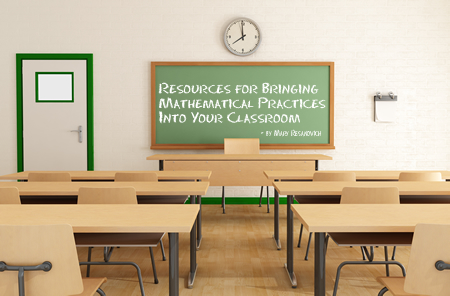 The focus in math classrooms today is meant to be on more than simply leading students to find the right answer. The CCSS Mathematical Practice standards, as well as other process standards, are designed to encourage exploration of mathematical concepts, discovery of mathematical understandings, sharing of mathematical thinking, and lively classroom discussion as a key part of students’ experiences.
The focus in math classrooms today is meant to be on more than simply leading students to find the right answer. The CCSS Mathematical Practice standards, as well as other process standards, are designed to encourage exploration of mathematical concepts, discovery of mathematical understandings, sharing of mathematical thinking, and lively classroom discussion as a key part of students’ experiences.
In my previous post, Practice Makes Perfect: Using Practice Standards to Increase Classroom Engagement, I describe how putting mathematical processes and practices at the forefront of lesson planning can increase students’ understanding and engagement. This may require a significant shift for some teachers, and it can be hard to know where to start. The resources below are a great place to both better understand the practice standards and to find inspiration and real-world tasks.
1. The CCSS Practice Standards Demystified
Still not sure what reasoning abstractly and quantitatively means? Unclear about how to make use of structure? Each link below clarifies the intent of each of the Common Core Mathematical Practice Standards.
2. Dan Meyer and Three-Act Math Tasks
Dan Meyers is a former high school mathematics teacher. His TEDTalk (TEDTalks: Dan Meyer: Math Class Needs a Makeover) is only 12 minutes long, and it’s a great model for developing math reasoning and patient problem solving in your classroom. If you are short on time, fast forward to 4 minutes 25 seconds to see an example of how to alter a textbook word problem to create what Dan calls “a problem worth solving.”
Dan’s blog is another source of both information and resources. Be sure to check out the Three-Act Math overview and the Three-Act tasks themselves. These are real world, non-routine problems for elementary, middle, and high school. The links provide everything you need to use these in your classroom, including video clips and animations, questions, and even follow-up problems. The great thing about these tasks is that they truly demonstrate to students that math is the language of the universe.
Hooked? You can find more Three-Act Math activities at these links:
- 3 Act Math: This site contains materials for grades 3 – 8, as well as high school courses.
3. Classroom Videos
Seeing how others put the practices into action can help you meaningfully incorporate them into your own classroom. Luckily there are lots of great video resources out there.
- The Teaching Channel – Table for 22: A Real-World Geometry Project
This is a 14-minute video of an activity which challenges students to discover the relationship between area and perimeter and to develop a deeper understanding of both concepts beyond simply applying the standard formulas. The video highlights the multiple math practices at play during the activity.
- Inside Mathematics
Each mathematical practice is linked to a set of videos, organized by grade level, which feature the application of the highlighted practice in the context of a lesson. You have the option of watching a portion of the lesson or watching the entire lesson. Clicking the link to see the entire lesson will also allow you to download handouts, lesson plans, and other materials.
- Illustrative Mathematics
This site provides videos illustrating each practice in action as well as pdfs of activities which include examples of student conversations and possible student approaches to the given task.
Mary is offering math tips as part of Mathematical and Statistics Awareness Month; you can find her previous post here. Stay tuned for more math features on our blog in the month of April!